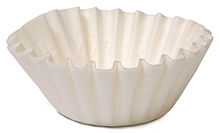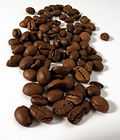Coffee filter

A coffee filter is a coffee-brewing utensil, usually made of disposable paper. This enables it to trap the coffee grounds and allow the liquid coffee to flow through.
Paper filters remove oily components called diterpenes; these organic compounds, present in unfiltered coffee are known to be antimicrobial and antiinflammatory. Metal or nylon mesh filters do not remove these components.[1]
History
On July 8, 1908, the first paper coffee filter was created by German housewife Melitta Bentz. She wanted to remove the bitter taste caused by boiling loose grounds or using the typical method of linen to brew coffee.[2] She patented her invention and formed a company to sell the coffee filters, hiring her husband and two sons to assist her as the first employees.
Paper filter

Coffee filters of paper are made from about 100 g/m2 crêpe paper. The crêping allows the coffee to flow freely between the filter and the filtration funnel. The raw materials (pulp) for the filter paper are coarse long fiber, often from fast growing trees. Both bleached and unbleached qualities are made.[3]
Typically coffee filters are made up of filaments approximately 20 micrometres wide, which allow particles through that are less than approximately 10 to 15 micrometres.[4][5]
For a filter to be compatible with a coffee maker, the filter needs to be a specific shape and size. Common in the US are cone-shaped filters #2, #4, and #6, as well as basket-shaped filters in an 8-12 cup size.
Other important parameters are strength, compatibility, efficiency and capacity.
If a coffee filter doesn't possess enough strength, it will tear or rupture, allowing coffee grains to collect in the coffee pot. Compatibility describes a filter medium's resistance to degradation by heat and chemical attack; a filter that is not compatible with the liquid passing through it is likely to break down, losing strength (structural failure). Efficiency is the retention of particles in a target (size) category. The efficiency is dictated by the particles or substances to be removed. A large-mesh filter may be efficient at retaining large particles, but inefficient at retaining small particles. Capacity is the ability to "hold" previously removed particles, while allowing further flow. A very efficient filter may show poor capacity, causing increased resistance to flow or other problems as it plugging up prematurely and increasing resistance or flow problems. A balance between particle capture and flow requirements must be met while ensuring integrity.
Other types
Metal filters are used to prepare Vietnamese iced coffee, Indian filter coffee, and other types of drip coffee. Japanese style Hook Bag coffee filter
See also
| Wikimedia Commons has media related to Coffee filters. |
- Drip brew
- French press (cafetière)
- Coffee pod (coffee bag)
References
- ↑ Cornelis MC, El-Sohemy A (November 2007). "Coffee, caffeine, and coronary heart disease". Curr Opin Clin Nutr Metab Care 10 (6): 745–51. doi:10.1097/MCO.0b013e3282f05d81. PMID 18089957.
- ↑ History of Coffee
- ↑ Paulapuro, Hannu (2000). "5". Paper and Board grades. Papermaking Science and Technology 18. Finland: Fapet Oy. p. 114. ISBN 952-5216-18-7.
- ↑ "Coffee Filter and Diatomaceous Earth". Princeton.
- ↑ "Seal face lubrication". McNally Institute.
| |||||||||||||||||||||||||||||||||||||||||||||||||||||
